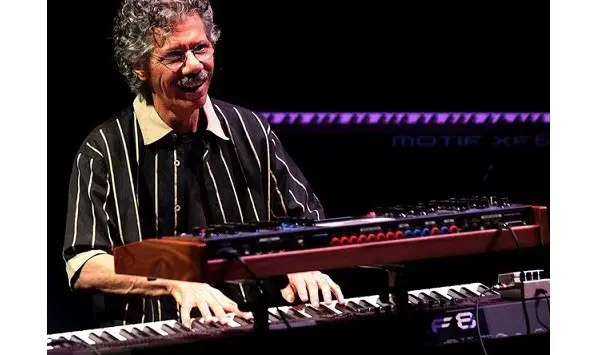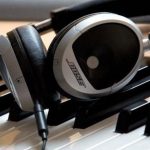
Jazz pianist Chick Corea says there’s a lot you can learn about Music (and keyboards) from Recordings. Chick Corea shares tips and suggestions on how to get better at keyboards and music by following others.
There’s a already a lot of information out there on the internet which suggests how several musicians became great at their craft, without having formal lessons in music. And the way they became better is by closely listening to how other great players played and listening to recordings.
Chick Corea says a great way to develop the ability to hear melodies, harmonies, and rhythms is to copy things from recordings.
Adopting the Apprenticeship System
Chick Corea says the apprenticeship system is really indispensible in learning anything, including music.
This way of learning is actually the most standard, and the most traditional, way of learning that exists in the world. The way anyone learns anything is first to seek out the person or group of people who are doing what you want to learn, and then, bit by bit, to find out how they do it.
I think you’ll find that once you yourself have traced down a melody note-for-note off of a recording, and in the process have gone over and over and over that melody, you’ll really begin to grasp the mechanism which is at the basis of ‘hearing’ melody lines. (Of course, this applies to harmonies and rhythms, as well.)
The idea is that you learn something by copying exactly the ways it’s done, until you make that particular technique your own, at which time you can apply it toward your own creations.
Give it Your Own Twist
Music students would love to know how to add uniqueness to any piece of music.
Chick Corea says the idea of making it your own is quite interesting. This partly involves a real willingness to create different being-nesses, different personalities and emotions. It’s very similar to the ability actors need. Of course, when this is done causatively, there’s no loss of one’s own identity. When it’s not being done causatively, however, then one is not being oneself.
So that’s a part of the attitude aspect of ear-training: Now to the actual technique aspect of it. In the field of music, we have a vast reservoir of knowledge documented on recordings. When looked at from the student’s point of view, this is an invaluable source of learning. You can almost do a full apprenticeship with an artist who’s done a lot of recording just by learning to duplicate the techniques he or she has used on records.
The process can be put into logical steps, but let me give you the general procedure to begin with. Generally, what happens is that you hear some music that you like, and you begin to listen not only as a listener and an enjoyer of the music, but also as a student with an eye toward figuring out how the artist creates those particular sounds. You’ll then try to do some of what you’re hearing; you’ll recreate parts of it, until you understand it thoroughly enough to use it in your own creations.
I got a chance to listen to and watch Thelonious Monk and his quartet play two shows a night, for six weeks. It was a great education. There was my university, man. Chick Corea
Specific Techniques That You Can Use
Now you can get very conscious and analytical about this, and actually get specific.
- Step One would be to find a recording that has the sound that you’re looking for. That sound could be, for example, the complete style of a particular pianist, or it could be an aspect of playing that different pianists do in different ways. It might be that you so much love the way Art Tatum plays that you want to learn a lot of the techniques that Tatum used, so you can play using that style. Or you may be interested in, say, various ways of voicing left-hand chords and you may get as diverse in your listening as listening to a Bud Powell recording and a McCoy Tyner recording.
- Step Two would be to copy down and then learn to play the passages that you’re interested in. I’ve found that actually notating the notes is the most complete way to learn a bit of technique, but you can do it using your ear and memory if you prefer. The trick here is to choose a part of the musical structure you’re analyzing that’s not more complex than what you’re able to copy down. For instance, you might just work on the melody line of the piece, or even just a portion of it. You can take this copying-down sequence on the proper gradient and work up your hearing ability until you’ll find you’re able to copy down quite complex pieces of music. This process can be very exciting and revealing.
Patience should be taken by going over and over the part you’re working on till each note is exactly right. For instance, if there’s a ten-note phrase that you want to get, and the fourth, fifth, and sixth notes are difficult, play the phrase up to the fourth note and then lift the needle quickly so that just the four note is left hanging. That way, you’ll be able to get it.
Watch: Chick Corea on LEGENDS OF JAZZ - Step Three would be to play the passage on your instrument. Play it over and over again until you have the phrase or phrases down smoothly. Then play it over and over again with the recording, and get all the nice nuances of phrase exactly as they are on the recordings. If you do that with enough of the recordings of a particular pianist, you can begin to really get how he creates and how he thinks and puts his systems and language together.
You can take this sequence of finding a recording, copying the music down, and playing it on your instrument along with the recording, and do a great deal with it. It can be a fantastic process of self-learning and discovery, and quite different from having the music already transcribed for you, in which case, you don’t usually take the time to actually listen to how the intervals and phrases are put together.
Have fun with this. I hope what I’ve said will be of some help to you.
KeytarHQ editorial team includes musicians who write and review products for pianists, keyboardists, guitarists & other musicians. KeytarHQ is the best online resource for information on keyboards, pianos, synths, keytars, guitars and music gear for musicians of all abilities, ages and interests.



Leave a Reply